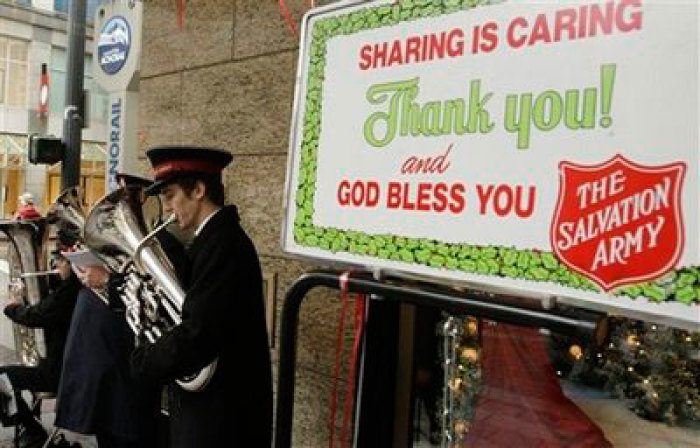Author Looks at Salvation Army Founders' Love Story as 150th Anniversary Approaches

Next year will mark 150 years since the founding of the worldwide organization The Salvation Army in London by William and Catherine Booth.
The Salvation Army's International Congress, which has representatives from over 120 nations, will meet in the city of its birth in July of next year and mark the milestone.
As the sesquicentennial draws near, journalist and broadcaster Cathy Le Feuvre has written a book, titled William and Catherine: The love story of the founders of The Salvation Army, documenting the romantic relationship of the husband and wife founders. Le Feuvre looked at the courtship and piety of the Booths.
A former Head of Media for the Salvation Army (UK), Le Feuvre drew upon the many letters written between William Booth and Catherine Mumford, which showcased both a strong faith in God and strong feelings for one another.
"For most of the time they were together, from their first meeting in 1852 until Catherine's death in 1890, they wrote to each other," wrote Le Feuvre in the book. "As I read some of the accounts and memories of those who actually met the Founders, the more real they became for me."
Residing in the United Kingdom, Le Feuvre responded to an email query from The Christian Post regarding her work. Below are excerpts from her response.

CP: How did it feel to read through the love letters of William and Catherine when researching the book?
Le Feuvre: When I saw the ORIGINAL letters, William and Catherine immediately became more than historic figures to me. Suddenly, they were no longer 'THE FOUNDERS' of a nearly 150 year old worldwide movement but just two people, in love, writing heartfelt notes, sharing their day-to-day lives, pouring out their love for each other, sharing their inner most secrets on life and faith.
To see their original handwriting – some of the pages very faded – was amazing. It gave me a great insight into their characters, I think.
William's handwriting was often rather flamboyant. He would embellish some letters in a very artistic fashion. At one point he writes the name "Catherine" and he has obviously taken time to make the letters incredibly beautiful, as if wanting to show her how much she is loved.
Catherine's writing is a little more 'controlled' and neat – perhaps an indication that she was better educated than William – but also I believe an indication of her very nature. Very thoughtful, more precise.
Reading the letters, I really entered their world. I saw them scribbling under the dim light of a candle or gas light. I imagined them dipping their nibs into the ink well … They became "real" people.
CP: The book was comprised of the letters between William and Catherine, italicized dramatic prose, and non-italicized normal prose. Why did you decide to do that type of format?
Le Feuvre: The book was always going to contain the letters, or extracts from the letters – this was the vehicle I used to tell William and Catherine's story. The letters dictated their story and the way I told it. Of course, I wanted to ensure that the reader understood the historic context (Victorian England/society) in which the letters were written, hence the "normal" prose.
But, as indicated before, when I read the letters, the characters of William and Catherine just jumped off the pages. The dramatic prose arose from that inspiration. Many of those stories also incorporated facts and information I had gleaned from my many months of research but which I wanted to present in a slightly more engaging way that just saying "this happened" or "that happened." These creative stories were also a way for me to share with my readers something of my imagination and excitement about what I discovered about William and Catherine.
CP: William and Catherine was released last year. What has been the response to your book thus far?
Le Feuvre: I've been very pleased with the response so far. Many people have been kind enough to say they have enjoyed reading the book and have, as I had hoped, really felt they connected with William and Catherine as individuals.
The book, so far as I can tell, is being read inside The Salvation Army and outside, and also not just by "religious" people. Many people – even those who I thought knew a lot about Salvation Army history and the Booths – have written and spoken to me saying that they discovered things they did not know. One or two have been generous enough to say it was because I presented facts perhaps already known in a new and interesting way. One or two have even said they couldn't put the book down because they found it such a good read. That's very flattering.
CP: Next year marks the 150th anniversary of the creation of The Salvation Army. What do you believe are some of the things people should focus on when observing this milestone?
Le Feuvre: From my perspective, I think it is important to "celebrate" the start of this Christian movement which William and Catherine Booth created as they sought to find their way in the world.
But on a personal level, I would hope that we would all not just celebrate the past but understand that this movement is an organic organization which grows and adapts to needs. Just as our own faith, when grounded in Jesus Christ may be a solid foundation, but which may lead us down paths we cannot yet even imagine.
William and Catherine didn't begin with the intention of creating another "church" or Christian denomination, but because of the needs of the people who joined, who wanted to be a community, that is what it has become.
Just as William and Catherine allowed themselves to be guided by the Holy Spirit, I would hope that the 150th anniversary of their Christian movement might encourage us all to be as open to God's call on our lives, no matter the difficulties and challenges and unexpected changes which that might present us with.






























